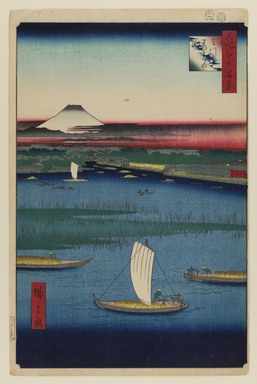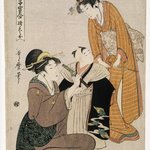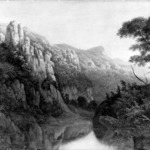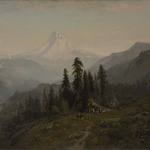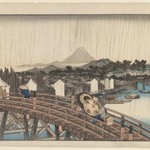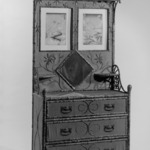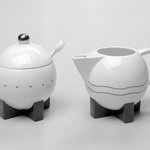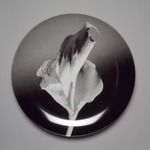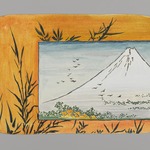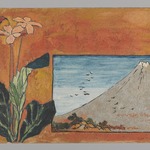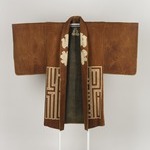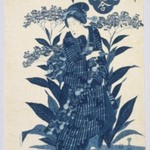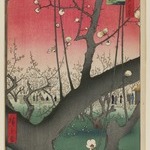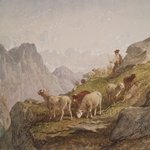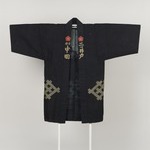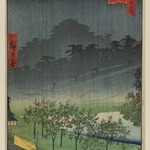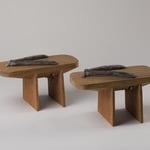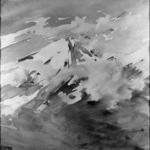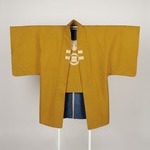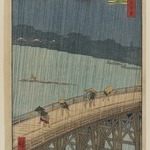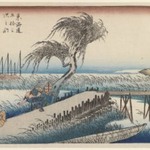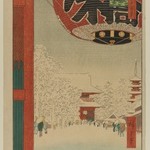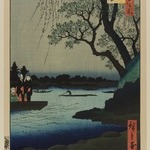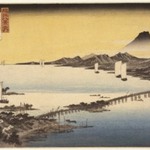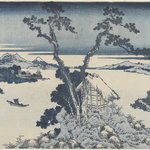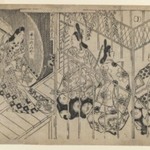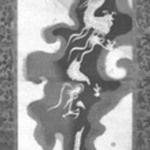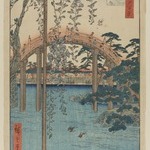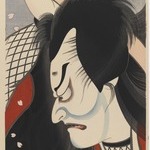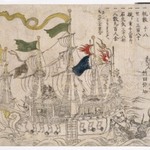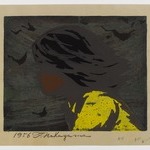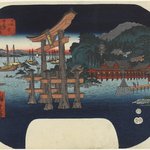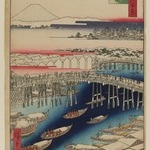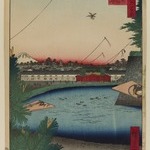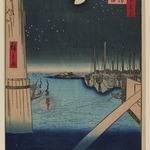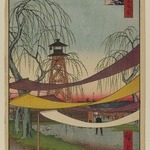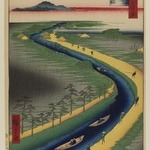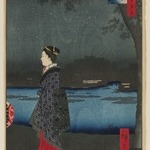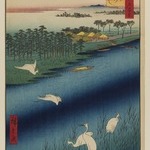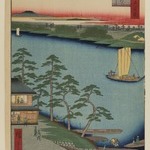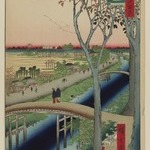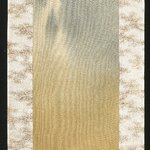Mitsumata Wakarenofuchi, No. 57 from One Hundred Famous Views of Edo
Utagawa Hiroshige
Asian Art
Here we look southwest toward Mount Fuji over the widest stretch of the Sumida River, a point where there is both a "fork" (Mitsumata) between the main channel and the Hakozaki Canal in the middle distance and a "dividing pool" (Wakarenofuchi) where tidewater and freshwater part. Perhaps the most revealing aspect of this view is what is not visible but what could not have been absent from Hiroshige's mind. An eight-acre island called Nakazu had been constructed here in the early 1770s precisely where the boats and reeds are positioned. This "Middle Strand" (nakazu) soon became the new pleasure center of the city, with ninety-three teahouses, three bathhouses, and various restaurants. Destroyed in 1789, it was reclaimed by the Tokyo government in 1886.
MEDIUM
Woodblock print
DATES
2nd month of 1857
PERIOD
Edo Period, Ansei Era
DIMENSIONS
Sheet: 14 1/4 x 9 5/16 in. (36.2 x 23.7 cm)
Image: 13 1/2 x 9 in. (34.3 x 22.9 cm)
(show scale)
MARKINGS
Publisher: Shitaya Uo Ei
SIGNATURE
Hiroshige-ga
ACCESSION NUMBER
30.1478.57
CREDIT LINE
Gift of Anna Ferris
PROVENANCE
Prior to 1930, provenance not yet documented; by 1930, acquired by Anna Ferris of Summit, NJ; 1930, gift of Anna Ferris to the Brooklyn Museum.
Provenance FAQ
CATALOGUE DESCRIPTION
This scene looks at the widest stretch of the Sumida River, with a most striking view of Mount Fuji, with black peak and white skirt. This point is where the Sumida River divides in the fork (Mitsumata) between the main channel, which flows under the Eitai Bridge (not visible here) into Edo Bay and the Hakozaki Canal, in the center distance, flowing under the Eikyu Bridge. The island to the left was occupied by daimyo mansions for reasons of defense. "Wakarenofuchi" (dividing pool) is the place where the tide water and fresh water parted in this shallow flat near the mouth of the river. In the past there were teahouses (where the boats and reeds are in this view), in an area known as Nakazu, which thrived until 1789 when it was destroyed by the reformist regime of Matsudaira Sadanobu, as a crackdown on immorality. Today Nakazu is a tract between Kiyosu Bridge and the elevated highway which has replaced the Hakozaki Canal.
MUSEUM LOCATION
This item is not on view
CAPTION
Utagawa Hiroshige (Japanese, 1797–1858). Mitsumata Wakarenofuchi, No. 57 from One Hundred Famous Views of Edo, 2nd month of 1857. Woodblock print, Sheet: 14 1/4 x 9 5/16 in. (36.2 x 23.7 cm). Brooklyn Museum, Gift of Anna Ferris, 30.1478.57 (Photo: Brooklyn Museum, 30.1478.57_PS20.jpg)
IMAGE
overall, 30.1478.57_PS20.jpg. Brooklyn Museum photograph, 2023
"CUR" at the beginning of an image file name means that the image was created by a curatorial staff member. These study images may be digital point-and-shoot photographs, when we don\'t yet have high-quality studio photography, or they may be scans of older negatives, slides, or photographic prints, providing historical documentation of the object.
RIGHTS STATEMENT
No known copyright restrictions
This work may be in the public domain in the United States. Works created by United States and non-United States nationals published prior to 1923 are in the public domain, subject to the terms of any applicable treaty or agreement.
You may download and use Brooklyn Museum images of this work. Please include caption information from this page and credit the Brooklyn Museum. If you need a high resolution file, please fill out our online
application form (charges apply).
The Museum does not warrant that the use of this work will not infringe on the rights of third parties, such as artists or artists' heirs holding the rights to the work. It is your responsibility to determine and satisfy copyright or other use restrictions before copying, transmitting, or making other use of protected items beyond that allowed by "fair use," as such term is understood under the United States Copyright Act.
The Brooklyn Museum makes no representations or warranties with respect to the application or terms of any international agreement governing copyright protection in the United States for works created by foreign nationals.
For further information about copyright, we recommend resources at the
United States Library of Congress,
Cornell University,
Copyright and Cultural Institutions: Guidelines for U.S. Libraries, Archives, and Museums, and
Copyright Watch.
For more information about the Museum's rights project, including how rights types are assigned, please see our
blog posts on copyright.
If you have any information regarding this work and rights to it, please contact
copyright@brooklynmuseum.org.
RECORD COMPLETENESS
Not every record you will find here is complete. More information is available for some works than for others, and some entries have been updated more recently. Records are frequently reviewed and revised, and
we welcome any additional information you might have.
